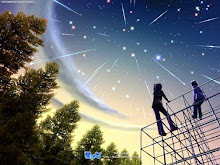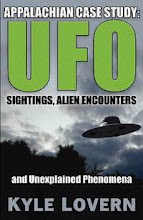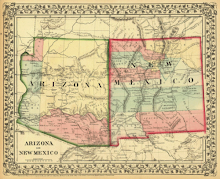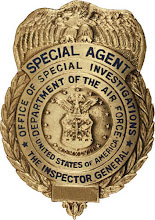skip to main |
skip to sidebar
By Steve Hammons
In December 2017 the New York Times broke the story about a top secret Pentagon project called the Advanced Aerospace Threat Identification Program (AATIP). In connection with that news, three declassified videos from U.S. Navy fighter jets were released to the public.
The videos showed what the Navy is calling “unidentified aerial phenomena (UAP).” And Navy pilots gave first-hand accounts of their interactions with unusual objects while at sea with aircraft carrier strike groups.
For people who were curious about or interested in the topics of UFOs and other “weird science” – and some people who weren’t – the release of this information seemed quite significant. Some national security experts and those in Congress made public their concerns and views about the situation.
But since many stories about UFOs are not at all new, and a number of researchers have looked into the subject over the decades, these new developments might seem like just another piece of the mysterious puzzle.
Reflecting interest in the overall subject, Roswell, New Mexico, has been drawing crowds for their annual UFO-themed celebration for many years. Several other towns around the country have similar events, along with occasional conferences featuring UFO researchers and interested citizens.
SAFETY BRIEFING
Movies, TV shows, books and other media have told us many stories of allegedly real, or possibly real, incidents about UFOs. These stories can generate skepticism, amazement and wonder, hopefulness, curiosity or even concern and anxiety.
Still, the lure of places like Roswell seems to fascinate many people.
And it’s not just UFOs. A number of other unusual phenomena also draw certain types of travelers and adventure-seekers who want to explore mysteries of various kinds.
Luckily, sometimes these locations are also in beautiful areas of our country from the Pacific Northwest to the Southwest, Midwest, South and New England. Some are populated regions, some rural and some in wilderness areas.
The same common-sense safety guidelines apply to UFO tourists as other travelers. Be respectful of your surroundings. Avoid dangerous areas. Watch out for sketchy characters. Don’t feed the bears in the Smoky Mountains. Don’t pet the bison in Yellowstone. Don’t fall off the edge of the Grand Canyon taking a selfie.
And don’t get close to a UFO as there have been reports of various kinds of injuries such as radiation burns, as well as other concerning reports and stories.
A firefighter training manual published in 1992 called "Fire Officer's Guide to Disaster Control" instructed fire service and EMS first responders that the two main hazards of UFOs are powerful anomalous energy fields and psychological impacts. In fact, there is a section in the book called “Adverse Potential of UFOs.”
UFO dangers can include unusual beams or rays, according to the manual. And mental effects from encounters with UFOs can include hypnotic, disorienting, fearful, confusing or paralyzing mental and emotional states.
The book’s authors also point out that proximity to UFOs has been associated with impacts like disruption of power grids, vehicles, aircraft and communications which could also affect firefighter operations and public safety.
So now that we’ve had our safety briefing, what’s another interesting area to visit as UFO and adventure travelers besides Roswell?
UFO VACATIONS EAST AND WEST
According to many or most researchers, after the alleged Roswell crash in the summer of 1947, the debris was promptly flown to Wright-Patterson Air Force Base in Dayton, Ohio. The base was then, and is now, a center for the analysis of foreign aircraft.
The Air Force's UFO research operation known as Project Blue Book operated from Wright-Patterson AFB from 1952 to 1970. And the second season of the A+E History Channel TV series "Project Blue Book" about it will be out soon.
"Wright-Patt" is also home of the National
Museum of the United States Air Force, the offical museum of the Air Force. It reportedly is the largest and oldest museum on military aviation on the planet.
Although the museum does not yet have a UFO exhibit, visitors can explore a number of educational encounters about the history of flight, the development of modern aircraft, the role of air power in our national defense, future development of our aerospace knowledge and capabilities (which might be related to UFOs?), and the list goes on.
You don’t need to “storm Wright-Patt” to encounter this knowledge – admission and parking are free! Museum hours are 9 a.m. to 5 p.m. daily.
Okay, the National Museum of the U.S. Air Force is not a secret vault for UFOs (as far as we know), but just being in the proximity of a historic base like Wright-Patterson is quite an experience in itself. Use your imagination!
When you think about it, when Dayton locals Wilbur and Orville Wright started flying their invention, it was an unidentified, anomalous, aerial flying object or phenomenon.
How about out West?
In addition to Roswell, two other well-known alleged incidents involve the two towns of Aztec and nearby Farmington, New Mexico, 15 miles apart. Some researchers have claimed or suspected that in 1948 a UFO crashed or made a controlled crash landing outside of Aztec. That was the year after the alleged Roswell crash. And in 1950, the people of Farmington witnessed three days of an “armada” of unusual objects in the sky – many, many unidentified objects.
The Farmington area was the site
of a recent movie shoot for “Jumanji: The Next Level.” In fact, the headline for a Dec. 24 article in the Durango
Herald newspaper in nearby Durango, Colorado, asks, “Could Farmington be the next
Hollywood?”
Aztec and Farmington are in the well-known Four Corners region where the states of Arizona, Utah, Colorado and New Mexico intersect.
The ancient Native American ruins at Chaco Canyon
National Historical Park, Mesa Verde
National Park and Canyons
of the Ancients National Monument are nearby, and thousands of people visit those areas each year. The town of Cortez, Colorado, is a good base of operations to explore Mesa Verde Country. The Crow Canyon Archaeological Center four miles outside of Cortez is a fantastic look into the past. The center has a lodge and cabins.
Northeast of Cortez and higher in the mountains is Telluride, known for skiing and the annual film festival there.
A bit further east in nearby Durango, Colorado, the famous old-time train, the Durango & Silverton Narrow
Gauge Railroad, takes thousands of visitors from around the country and the world up and down the rugged San Juan Mountains. The train takes daily trips to the town of Silverton, deeper into the San Juan National Forest, and back to Durango.
It's actually only a short distance between Silverton and Telluride "as the crow flies." But that crow would have to fly over some massive mountains. The scenic, winding roads between the two towns follow the few paths available through those mountains.
That area is also a travel destination for outdoor activities like hiking, fishing, camping, ziplining, soaking in hot springs, river rafting, and in winter, skiing, snowboarding, outdoor winter activities – and maybe more soaking in hot springs. The Purgatory Resort is great for winter sports and summer activities.
UFO tourists and outdoor adventure travelers in the Southwest need some cowboy grub and a few good cowboy songs once in a while. When in Durango, check out the Bar D Wranglers Old West Cowboy Music
Show and Chuckwagon Supper north of town, "Durango's favorite family entertainment since 1969."
One of my personal favorites is “Riding for the Roundup (in the Springtime),” on YouTube with the current Wranglers
and an older version. Although once in a while they might sing on key, give a
couple of their instrumental songs a listen – “Red Cliff” and “Clarinet Polka.”
There’s a lot of wildlife up in those mountain forests. If
you’re stealthy and respect Nature, you can immerse yourself in and interact
with that ecosystem. The Bar D Wranglers’ thoughtful tune “Man Walks Among Us”
might get you in the mood for that. So, UFO and outdoor adventure tourists, “Saddle Up.”
Also in the Durango area, the Continental Divide goes through that exact region, extending north to Alaska and south to South America. Water from the the west side of the divide flows to the Pacific Ocean, and to the Atlantic on the east side. The Continental Divide National
Scenic Trail is a popular route for serious hikers.
Also in the general Four Corners region is Sedona, Arizona. That area is world-renown for the beauty of its amazing red rock cliffs and rock formations. It’s said that there are unique geomagnetic forces at work in the Sedona area causing unusual effects on people. These “vortexes” of some kind of Earth energy are believed by some to possibly be related to the geology of the area – high iron oxide, high quartz and certain underground volcanic formations.
Yes, UFOs and unusual incidents have been reported in the Sedona area. So when hiking the beautiful red-earth trails and red rocks, and feeling those geomagnetic vortex vibes, it might be good to keep an eye on the sky too.
A bit southeast of Sedona and Flagstaff (home of Northern Arizona University) you will find the Apache-Sitgreaves National Forests where the alleged UFO incident occurred involving a forest-clearing crew. That case was the basis for the movie “Fire in the Sky.”
Both those national forests and nearby Coconino
National Forest to the northwest include thousands of acres of ponderosa pines covering the mountains around Flagstaff and the Mogollon
Rim, a picturesque and defining southern edge of the Colorado Plateau and the Colorado Plateaus
Physiographic Province. Great for hiking and camping.
Is UFO tourism an emerging trend? We’ll have to wait and see, but there seems to be a trajectory of more public interest in this topic and its alleged history – and future.
(Related article “Storytelling affects human biology, beliefs, behavior” is posted on the CultureReady blog, Defense Language and National Security Education Office, Office of the Undersecretary of Defense for Personnel and Readiness, U.S. Department of Defense.)
By Steve Hammons
All hands on deck! It’s going to take a team effort for the U.S. to deal with a very unusual situation involving “unidentified aerial phenomena (UAP)” that might be a serious threat – or something else, according to a national security expert.
In May 2019, a U.S. Navy spokesperson stated, "There have been a number of reports of unauthorized and/or unidentified aircraft entering various military-controlled ranges and designated air space in recent years …”
This quote is presented by national security veteran Christopher Mellon at the beginning of an article he wrote June 29, 2019. The article, or report, titled “Potential Sources of Information Regarding Unidentified Aerial Phenomenon,” was included in an e-newsletter dated Nov. 12 and distributed Nov. 15 from the start-up "public benefit" company called To The Stars Academy of Arts and Science.
Mellon serves as national security affairs director and advisory panel chairman for the company and has a significant background in the U.S. national security community.
Mellon writes that, “… the U.S. Navy’s public recognition of the problem is an excellent first step towards mobilizing the military and the Intelligence Community to find answers regarding the identify of these vehicles and determine whether they pose a threat to the United States.”
Is it really the “first step” for the Navy, other military branches and our national security community? Movies, TV shows and books have told us many stories of a “UFO situation” emerging for the U.S. in the World War II era and the 1950s.
But if we examine Mellon’s comments more closely, he specifies that the Navy announcement is a good first step “towards mobilizing the military and the Intelligence Community to find answers …” He seems to want to expand size and scope of the U.S. personnel and resources that probably have already been working on this issue for several decades.
UNKNOWN OBJECTS INCREASE UNPRECEDENTED
As has been reported in news stories over the past two years, the U.S. Navy has encountered and tracked multiple unusual unidentified objects near aircraft carrier strike groups at sea off the west and east coasts, and elsewhere, over a number of years.
Mellon provides some words of concern. “The UAP phenomenon off the East Coast of the US in recent years is unprecedented in terms of the number and appearance of the vehicles involved as well as their persistence in a specific geographic region.”
There seems to be a certain urgency in Mellon’s message. “It suggests not only a new level of brazenness or contempt for US defense and intelligence capabilities, but also the possibility that operations have advanced to a new stage towards some as yet unknown objective.”
The phenomena is not new, he acknowledges. “There have been numerous instances over the years of UAP intrusions over military facilities, some which I can personally attest to or am aware of with one degree of separation,” Mellon wrote in his article.
“For example, in March of 1984, a close friend who was training to become a naval aviator called me excitedly from Pensacola NAS [Naval Air Station] to relate an event involving a UAP flying circles around a USN aircraft in broad daylight over the base.”
“Numerous incidents involving UAPs and military facilities have been reported by retired military personnel and validated via the FOIA process. These reports include verified UAP overflights of nuclear weapons and nuclear storage facilities,” Mellon pointed out.
“Consequently, a review of these cases might help shed important new light on the question of reported UAP interest in the US strategic triad and nuclear chain of command (Note: I have not listed undersea monitoring capabilities due to classification issues although they are obviously highly pertinent to this question).”
Wrapping our minds around the situation may be difficult but necessary, Mellon counsels us. “The UAP issue is already uniquely challenging. It lacks recognition or understanding; it lacks acceptance; there is a serious stigma to overcome …”
We should increase our preparedness and readiness on several levels, he says. This includes our psychological and emotional preparedness and readiness, Mellon seems to say when he writes, “… and even more difficult is the deceptively serious challenge of helping government officials and the public process such incongruous, disorienting, disruptive and potentially disturbing information.”
“Finally, if these are vehicles created by another species there is the wholly unprecedented challenge of seeking to study an intelligence greater than our own that apparently does not wish to communicate or be understood.”
So what the heck is going on? Mellon doesn’t claim to know, or doesn't say – but does state, “To even stand a chance of success in this scenario it seems trite to suggest that we need to draw on all pertinent information available and apply the best and brightest analytical minds available.”
He may not have all the answers for us, but Mellon appears to have some worthwhile questions:
- “Are different kinds or types of vehicles associated with different locations, time-frames or types of targets? If so, are we possibly dealing with multiple, potentially even competing actors?”
- “Is there a pattern that suggests an ongoing effort to monitor the US strategic triad or nuclear command and control?”
- “Is there a pattern that suggests an effort to monitor US weapons development and deployment?”
- “Is there a correlation between advances in US technology and the presence of UAPs?”
COUNTERMEASURES USING EXISTING RESOURCES
In his article, Mellon also explores U.S. government assets that he believes could be used to respond to the UFO and UAP situation. He indicates that these efforts are inadequate and he lists several national security resources and systems that he says could be helpful.
If there have been classified and special activities related to this situation, Mellon seems to believe that these can be strengthened by additional resources and personnel.
Referring to the vast national security systems of our country, he writes, “Hopefully, the US officials charged with investigating the UAP phenomenon will receive the support needed to access and analyze data from these and other sources.”
And again referring to coordinating and making use of existing defense resources, Mellon states, “Since billions have already been spent collecting the information, it seems wasteful and inappropriate not to allocate whatever modest sums may be required to help to resolve vital questions regarding the origin and capabilities of the unidentified vehicles that continue to violate US airspace with impunity.”
Mellon wrote, apparently to the best of his knowledge, that, “Because this phenomenon has only recently been acknowledged, little if any effort has been made to use ‘national technical means’ for purposes of identifying or tracking these objects.”
He says certain existing U.S. capabilities can be utilized for analysis of previous UAP incidents as well as ongoing and future encounters, and provides the following lists as well as additional details:
Collection Systems:
- The Global Infrasound Acoustic Monitoring Network: Mellon describes the system as “comprised of 60 stations operating in 35 countries that monitor low-frequency pressure waves in the atmosphere.”
- The U.S. Space Surveillance Network “consists of at least 29 distinct world-wide space surveillance systems, including the world’s most powerful radars …”
- The Space-Based Infrared System (SBIRS) “is a network of satellites in low-earth, highly-elliptical and geosynchronous orbits that together provide nearly continuous global coverage of infrared (heat) sources,” Mellon noted.
- Active Electronically Scanned Array (AESA radars). He explained that, “In addition to the Navy’s Aegis radar systems, all military platforms outfitted with AESA radars are potentially valuable sources of information …”
- Aegis radar: “We know from the Nimitz incident that the Navy’s Aegis radar systems are capable of tracking low radar cross-section UAPs that operate at extreme altitudes and velocities,” Mellon writes.
- The Joint Surveillance System links the FAA’s long-range radar systems to the North American Aerospace Defense Command (NORAD), he explained.
Databases:
- “NORAD maintains a database called the ‘Unknown Track Reporting Database’ and/or ‘Unknown Track Reporting System’,” Mellon wrote.
- “Air Traffic Controllers (ATC) who staff the Federal Aviation Administration’s (FAA) airspace management sites (airports, alert centers, etc.).”
- “OPREP-3 Reports [operations reports] are an additional source of information distinct from NORAD aerospace defense reporting. This system is used by all branches of the military to report ‘urgent’ and ‘ongoing’ events to higher echelons,” according to Mellon.
And yet more assets can be brought to bear on these UAP challenges, he claims. As “other potential opportunities” to bring together robust resources, he includes the following:
- Allies
- ELINT/COMINT [electronic intelligence, communications intelligence]
- HUMINT [human intelligence]
By leveraging these capabilities and assets wisely, we can improve our preparedness and readiness for future developments, Mellon advises us.
(Related articles “Storytelling affects human biology, beliefs, behavior” and “Reagan’s 1987 UN speech on ‘alien threat’ resonates now” are posted on the CultureReady blog, Defense Language and National Security Education Office, Office of the Undersecretary of Defense for Personnel and Readiness, U.S. Department of Defense.)
By Steve Hammons
In an Oct. 27 article on the news and current events website The Daily Beast, writer David Axe notes the views of several space researchers on the topic of “first contact” with extraterrestrial visitors.
Recent disclosures about observations of unusual objects by U.S. Navy fighter pilots and other Navy personnel have seemingly sparked increased interest by many people about the topic of UFOs.
In his article headline, “How Will We Make First Contact With Alien Life?” Axe seems to take the position that we have not yet made contact.
He wrote, “Still, first contact is increasingly likely, scientists told The Daily Beast. Maybe tomorrow. Maybe a decade from now. Maybe much, much farther in the future. For human civilization, that encounter could change everything. Then again, it probably won’t.”
“The reaction will depend on people’s expectations,” said Douglas Vakoch, according to Axe. Vakoch heads the “Messaging Extraterrestrial Intelligence” organization.
JUST WAITING FOR CONFIRMATION
Vakoch also pointed out to Axe that many people apparently would not be surprised by such a development. Axe wrote, “And today millions of people already believe there’s life beyond Earth, he added. They’re just waiting for confirmation.”
That might be a reasonable viewpoint. Axe also reminds readers that, “Our galaxy alone includes no fewer than four billion planets that are similar to Earth.”
And there are also theories out there that we might discover different dimensions that are natural parts of the Universe. Visitors might originate from these types of home environments, according to some speculation.
For those people who somehow missed the multiple news reports over the last couple of years, Axe writes, “Navy pilots on at least two other occasions in recent years had similar run-ins with UFOs. Cockpit videos of the encounters have racked up millions of views on social media.”
Axe explains that U.S. government funding was made available to attempt to conduct responsible and thorough research into these Navy encounters. He notes that, “Amid a surge of interest in possible alien visitors, news broke that a trio of powerful U.S. senators for years channeled tens of millions of dollars [reportedly $22 million for a five-year effort] into a military-run office that investigated UFO sightings.”
To some taxpayers, that might seem like a wise investment. What are unusual, apparently foreign craft, drones or objects of some kind doing in the vicinity of Navy aircraft carrier strike groups at sea?
Retired Navy Commander David Fravor, formerly a Navy fighter jet squadron leader, has taken a leadership role in explaining his encounters to the public. And Axe included Fravor’s accounts in his article.
Axe wrote, “It appeared to be an aircraft of some sort. Oval in shape. Around 40 feet long. It hovered over the water, churning up waves and foam. Fravor steered the F/A-18 directly at the object. Abruptly the UFO sped away, Fravor told The New York Times. ‘It accelerated like nothing I’ve ever seen.’ He was, he said, ‘pretty weirded out. I have no idea what I saw. It had no plumes, wings or rotors and outran our F-18s’.”
BREAK IT TO ME GENTLY
It might be a delicate situation for the Navy. For decades, there have been reports of both overt and covert U.S. government monitoring and investigation of UFOs. The overt “Project Blue Book” in the 1950s and ‘60s operated from Wright-Patterson Air Force Base in Dayton, southwest Ohio. That project might have also had covert elements.
Additionally, there have been some indications that more discreet research has been done that has been kept highly confidential and compartmented, or even moved outside of the U.S. government organizational structure to maintain security.
Navy public information officers are probably able to take a constructive approach in orienting us. Axe wrote in his article that, “To avoid taking a firm stance on the subject of flying saucers, the Navy prefers to use the term ‘Unidentified Aerial Phenomena,’ or ‘UAP,’ to describe what everyone else calls ‘UFOs’.”
Of course, a key word difference in the terms is that “phenomena” represents a broader scope of situations than “objects.” Some of the unconventional things seen in the skies certainly seem to be solid objects, such as the UAP that Navy pilots observed. Other unusual phenomena in the skies at various altitudes (including ground-level) might not exactly be solid objects.
How do we move the ball forward on sharing information and understanding of this situation with the American people and people around the world? Does the Navy have a communication and orientation game plan? They might.
If Navy and other key national security people are going to prepare us and inform us in more complete and robust ways about UAP, how are they going to break the news to us?
Maybe exactly as they have done so far.
(Related articles “Storytelling affects human biology, beliefs, behavior” and “Reagan’s 1987 UN speech on ‘alien threat’ resonates now” are posted on the CultureReady blog, Defense Language and National Security Education Office, Office of the Undersecretary of Defense for Personnel and Readiness, U.S. Department of Defense.)
By Steve Hammons
In different ways, via different media platforms and with different stories to tell, five recent and significant media projects explore the southern Appalachian mountain area including the Ohio River region abutting Ohio, Kentucky and West Virginia.
“Country Music” – The recently-broadcast Ken Burns documentary “Country Music” on PBS is filled with Bluegrass and “old-time” mountain music, and stories about the history and people of the southern Appalachian region.
“Dark Waters” – The first movie trailer has been released for “Dark Waters” starring Mark Ruffalo and Anne Hathaway. The film is based on the true story of a Cincinnati attorney investigating reports of streams and waterways poisoned by toxic chemicals in nearby Parkersburg, West Virginia.
“The Pioneers” – Historian David McCullough’s recently-published best-selling book “The Pioneers” explores the history of that same area of southeastern Ohio abutting the Ohio River and West Virginia, particularly in the era of the 1700s.
“Hillbilly Elegy” – The controversial, best-selling book “Hillbilly Elegy” is about the growing-up years of author J.D. Vance in a small town between Cincinnati and Dayton. The migration of Kentuckians and Appalachians into the southwest Ohio area is a key part of his story. Ron Howard’s Imagine Entertainment has been filming the movie version for Netflix.
“Project Blue Book” – Dayton is also the setting for Season 2 of the A&E History Channel series “Project Blue Book.” The real Project Blue Book operated from Wright-Patterson Air Force Base in Dayton while investigating UFO reports in the ‘50s and ’60s.
BEAUTIFUL LANDS OF THE “OHIYO”
Back in the 1700s, "the Ohio country” was an attractive piece of real estate for the French, British and the government of a newly-formed alliance of former colonies called the United States of America.
The Shawnee, Cherokee and others who had lived in the area for tens of thousands of years also apparently liked the region.
Who can blame them? Pure and pristine creeks, streams, rivers and waterways flowed through lush forests covering the hills, mountains and valleys, eventually flowing into the vast river called the "Ohi yo" or ”Ohiyo.”
There was fishing, hunting, and plots of corn, beans and squash ("the three sisters"). Nuts, berries, edible wild plants and roots (including medicinal plants) were literally there for the picking. The land and forests provided plenty of building materials for permanent homes, villages and towns. Canoes provided transportation on the many waterways.
And like today, fairly harsh and dreary winters always finally gave way to beautiful spring seasons bursting with life, followed by warm summers and the spectacular autumn color show when the forest leaves covering the hills and mountains turn to bright red, orange and gold.
When Anglo, Scottish, Scots-Irish and other colonial explorers and settlers began interfacing with the people of the eastern slopes of the southern Appalachian mountain range (the Cherokee in many cases) there was a significant scope of friendly contact.
Before long, prior to and after the American Revolution, traditional Scottish and Scots-Irish tunes like those in “Country Music” would be echoing through those hills and mountains in Cherokee country, around campfires and in frontier cabins and communities.
As we know, as the 1700s progressed, so did the western expansion and migration of colonists and new “Americans” seeking land and a better way of life. They moved steadily deeper into the southern Appalachian mountain range, and eventually to the western slope of the range in Ohio, Kentucky and Tennessee.
After the American Revolution, as McCullough explains in “The Pioneers,” the new government passed the Northwest Ordinance of 1787. It basically claimed the “Northwest Territory” for the U.S. government -- what are now Ohio, Indiana, Michigan, Illinois, Wisconsin and part of Minnesota – and promptly started selling off large land parcels to investors and others. This also raised much-needed money for the new federal government. These lands had previously been claimed by the French and British.
FULL CIRCLE
Now, many generations later, more recent stories of the region are also informing us. And some current narratives seem to dovetail with important developments and interesting elements of the area’s deeper history.
The A&E History Channel series “Project Blue Book” essentially covers the period when the project was active at Wright-Patterson AFB from Dayton, 1952-1970. But the overall topic of what’s now being called “unidentified aerial phenomena (UAP)” reportedly might stretch back to WWII, earlier, or even much, much earlier.
Very recent reports and developments coming from the U.S. Navy on this subject seem worth noting, and might give us more insight about Project Blue Book activities.
Ohio itself and surrounding states have been areas where people have reported "UAP." Some of these reports have reportedly been credible and came from military personnel and public safety peace officers.
The book and movie “Hillbilly Elegy” tell a story of a generation or so later. The author was born in 1984 and spent his youth in a small town just south of Dayton in the ‘80s and ‘90s.
His family had roots in Kentucky and Appalachia, like many people of southern and southwest Ohio. Director Ron Howard and the cast and crew filmed for four days in the author’s hometown of Middletown.
And now the new movie “Dark Waters” will look at that same Ohio River region circa 1998 when reports of a farmer’s dead cows in the Parkersburg, WV, area led to the discovery of toxic chemicals in the waterways there.
Interestingly, part of the filming was done just south of Middletown in the town of Hamilton (sometimes known as “Hamiltucky”). And Parkersburg is just 13 miles downriver from Marietta, the town of McCullough's pioneers and 38 miles from Ohio University in Athens, founded by those same pioneers.
Mark Ruffalo plays the role of the real-life Cincinnati corporate attorney who took legal actions on behalf of the local people affected by the poisonings.
That might bring us around full circle to the deeper history of the confluence of the states of Ohio, Kentucky and West Virginia and surrounding areas, contrasting the “Dark Waters” case and our modern society with days long, long ago.
As we might remember, there once was a time when pure and pristine creeks, streams, rivers and waterways flowed through lush forests covering the hills, mountains and valleys, eventually flowing into the vast river called the "Ohi yo" or ”Ohiyo.”
(Related article “Storytelling affects human biology, beliefs, behavior” is posted on the CultureReady blog, Defense Language and National Security Education Office, Office of the Undersecretary of Defense for Personnel and Readiness, U.S. Department of Defense.)
By Steve Hammons
Filming for the upcoming movie “Hillbilly Elegy” is underway and the cast and crew, including director Ron Howard, will soon be heading to Middletown, Ohio, just south of Dayton in the southwestern part of the state.
Middletown is where part of the personal story of author J.D. Vance takes place. His best-selling and controversial non-fiction book of the same name tells a story about his upbringing in Middletown and Kentucky.
Meanwhile, historian David McCullough’s latest book “The Pioneers” takes a deep look at the changes that occurred in southeastern Ohio on the other side of the state in the late 1700s and early 1800s.
The American Revolution had ended and the new government of the United States of America claimed vast lands in Ohio and beyond, previously claimed by the French and British. The Northwest Ordinance of 1787 established how these lands would be settled and governed.
And Season 2 of the popular History Channel TV series “Project Blue Book” about the U.S. Air Force UFO research program is in the works, with a teaser-trailer on the Roswell incident recently released.
The real Project Blue Book was based at Wright-Patterson Air Force Base in Dayton (home of the Wright brothers) and officially operated from 1952 to 1970. The TV series is set there, with the Air Force investigators traveling to sites of UFO-related incidents.
On the surface, there does not seem to be any connection in these current and prominent media projects, other than the link to southern Ohio. Yet, maybe there are some common denominators and overlapping elements that could be interesting.
WHAT’S PAST IS PROLOGUE
One obvious overlap is that “Hillbilly Elegy” author J.D. Vance spent part of his challenging youth in Middletown in the 1980s and ‘90s, 27 miles south of Dayton. Project Blue Book had been investigating UFO incidents from Dayton for 20 years until more than a decade before Vance was born in 1984.
And while McCullough’s New Englander Revolutionary War veterans and investors were buying a piece of newly-available real estate in the deep forests and hills of southeastern Ohio (and founding Ohio University in Athens), others were eyeing southwestern Ohio around what is now Cincinnati (named after a Revolutionary War Continental Army officers' group).
Just north of Cincinnati along the Great Miami River, the towns of Hamilton, Middletown and Dayton sprang up. Today, this area is considered barely outside the official Appalachian region.
As McCullough explains in his book about southeastern Ohio, the designation of the new “Northwest Territory” (Ohio, Indiana, Illinois, Michigan, Wisconsin and part of Minnesota) as a non-slavery region led to other significant historical developments. It provided a moral compass of sorts, at least on the slavery issue.
This takes us back over to the southwestern side of Ohio again, because when the Northwest Territory was designated non-slave, many Quakers throughout the colonies, and the new U.S., moved from the South to north of the Ohio River.
Quaker migration to the colonies from England, Scotland and Ireland began in the 1600s and many settled in the southern colonies. They witnessed slavery first-hand. Slavery was not consistent with Quaker beliefs and perspectives.
As a result, when the Ordinance of 1787 passed, many Quakers headed north of the Ohio River (as did many African-Americans escaping slavery). An area just north of Cincinnati between the Great Miami River and the Little Miami River was sold by the government to investors and Quaker settlers, known as the Symmes Purchase or Miami Purchase.
The lands that were part of the Symmes Purchase extended up to the Dayton region.
Famous "Wild West" sharpshooter Annie Oakley was actually a Quaker girl from rural southwestern Ohio, still an area of many Quaker communities today.
And there are stories of significant Underground Railroad activities in the area involving local Quakers during slavery and the Civil War.
Pioneers, Quakers … and hillbillies. Southwestern Ohio and Cincinnati, Hamilton, Middletown, Dayton and points north and northwest have historically been towns where Kentuckians and people from the southern Appalachian Mountain region have migrated, looking for economic opportunity.
Hamilton, just south of Vance's hometown of Middletown, is known as “Hamiltucky.”
Pioneers, Quakers, hillbillies … and Germans. Several waves of German immigrants migrated to the Cincinnati area and southwestern Ohio, largely starting in the mid-1800s. Cincinnati was one of the major centers of German immigration to America. German culture is still a big part of the Cincinnati region.
Following World War II, when German rocket scientists were brought to the U.S. in “Operation Paperclip,” they were flown into and spent time at Wright-Patterson AFB in Dayton, a major Air Force aerospace research center. These Germans became key scientists for NASA and the U.S. space program (an issue explored in Season 1 of the "Project Blue Book" TV series).
Pioneers, Quakers, hillbillies, Germans … and UFOs. Wright-Patterson is not only associated with Project Blue Book, it has long been proposed that material from the alleged Roswell UFO crash in the summer of 1947 was flown promptly to Wright-Patterson for examination because the base was a center for foreign aircraft analysis.
What else about the southern Ohio area might add another enlightening, or confusing, puzzle piece to the mix?
Pioneers, Quakers, hillbillies, Germans, UFOs … and Native Americans.
HOSTILE ALIENS INVADE
When the new post-American Revolution U.S. government claimed the lands of the Northwest Territory that the British and French had previously claimed, no one checked with the Shawnee, Miami, Erie, Delaware, Huron, Wabash, Potawatomi and other Native peoples who lived there.
In Ohio, the Shawnee were a significant presence in both the southeast and southwest parts of the state. In southeast Ohio, the Shawnee, Mingo and Delaware fought the new pioneers and the military forces backing them at the bloody Battle of Point Pleasant near the Ohio River in 1774 (the site of UFO and multiple unconventional incidents in 1966-67).
The Shawnee kept fighting to protect their Ohio lands and way of life all the way to 1794 and the Battle of Fallen Timbers in northwestern Ohio. The famous Shawnee leader Tecumseh led an alliance of several tribes, but they were defeated by Gen. “Mad” Anthony Wayne’s troops and a force of Kentuckians.
Tecumseh's father had been killed 20 years earlier in the Battle of Point Pleasant.
Interestingly, Tecumseh was reportedly born on the Mad River near Dayton. Wright-Patterson AFB is located on that same river.
And just a bit northwest of Hamilton is Oxford, home of Miami University of Ohio, named for the Miami Indians of the area. In 1997, the school changed its mascot name from the Miami University Redskins to the Miami University RedHawks.
While the Shawnee homeland was north of the Ohio River (reportedly named from the Seneca word or words "Ohiyo" or "Ohi yo") to the south of the river were Cherokee lands in the southern Appalachian mountain region. Cherokee territory spanned parts of what are now Kentucky, West Virginia, Tennessee, Virginia, North Carolina, South Carolina, Georgia and Alabama.
The Cherokee intermixed and intermarried with white settlers, explorers, traders and hunters. Anglo, Scottish and Scots-Irish men found that Cherokee women were ready, willing and able to establish romantic encounters, relationships and marriages, notably in the 1700s. Mixed-ethnicity children were born.
Subsequent generations of these kids intermarried and continued marrying into the larger regional and U.S. population. This Cherokee genetic heritage is reportedly widespread in the southern Appalachian region, surrounding areas and beyond.
In fact, many mixed-ethnicity people of the region transitioned to the Anglo, Scottish and Scots-Irish names of their fathers and grandfathers (a big change from matrilineal, female-oriented Cherokee clan culture), could “pass as white,” and in many cases were mostly white.
This became important when Cherokees were rounded up at gunpoint and bayonet point, their homes, farms and lands stolen, put in holding camps and forced west to Oklahoma on the “Trail of Tears” in 1838-39. Thousands of Cherokee died along the way including babies, children, the elderly, women and men.
And over the decades, many of the families with Cherokee background who did not leave on the Trail of Tears no doubt migrated to southern and southwestern Ohio with other Kentuckians and people from the southern Appalachian region.
And here is a Project Blue Book connection: Today, some researchers and investigators looking into UFOs, unconventional phenomena, exotic “weird science” and forward-leaning possibilities have noted connections to American Indian history and Native American lands today.
In the Pacific Northwest, Arizona, Utah, the Four Corners area and Indian Country around the U.S., reports of UFOs and very unusual incidents and situations have drawn researchers’ interest.
Some Native cultures incorporate the assumption that there are “sky people” who have visited from time to time as well as unusual phenomena of other kinds.
It has been pointed out by some observers that American Indians encountered a technologically-superior civilization from England, France and Spain who invaded, and in a slow-motion conquest, took Indian land and killed tens of thousands of Native children, women and men through warfare and the spread of deadly disease epidemics.
Is this a warning for us today?
McCullough’s pioneers in southeastern Ohio spelled the beginning of the end of the Shawnee in Ohio, and reflected the fate of many other American Indian people.
Vance’s hillbillies include the broad scope of "hybrid" Appalachians and others who may have Cherokee DNA in the family tree – Cherokee who were significantly affected by the European pioneers.
And Season 2 of "Project Blue Book" again continues to tell the unfolding story of UFOs and the U.S. government's involvement from the focal point of Wright-Patterson AFB in Dayton, center for the study of aerospace technology and near the birthplace of Tecumseh.
In these modern media projects and histories of the region, are there patterns to perceive? Clues to investigate? Lessons to learn? Insights to discover?
(Related articles “Storytelling affects human biology, beliefs, behavior” and “Reagan’s 1987 UN speech on ‘alien threat’ resonates now” are posted on the CultureReady blog, Defense Language and National Security Education Office, Office of the Undersecretary of Defense for Personnel and Readiness, U.S. Department of Defense.)

























































































































































































